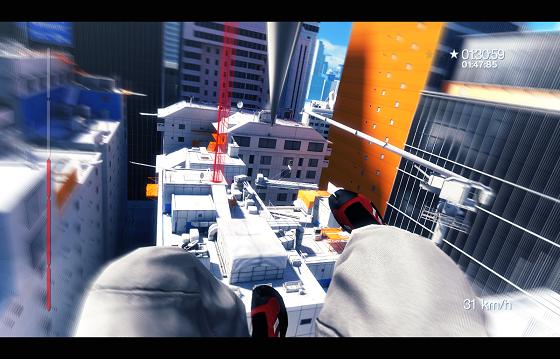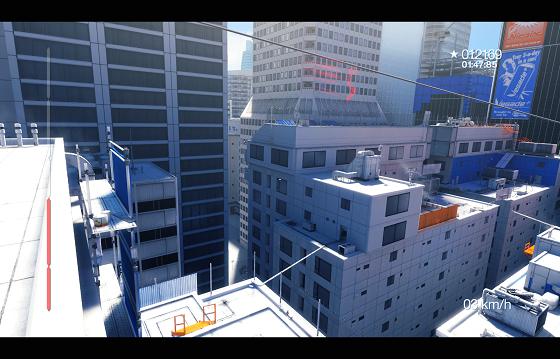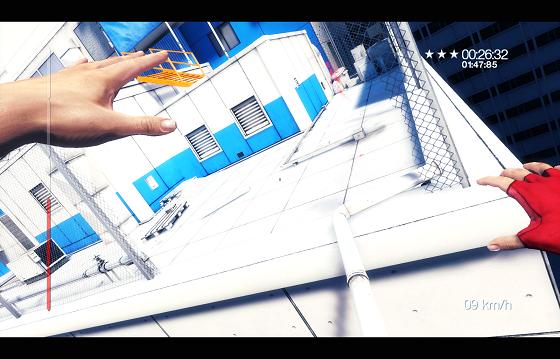
Mirror’s Edge generated some good buzz when it was first announced with its very unique list of features: a parkour action game in an immersive first-person view, a dystopian city setting with a distinctive aesthetic, even a protagonist that plays against video-gaming stereotype. Faith is a Eurasian girl with a slight build (meaning small boobs) and wears a utilitarian vest with cargo pants rather than bikini armor or other such ridiculous garb. Unfortunately, critical opinion turned negative when it emerged that the impressive cityscape is mostly for show as Faith’s path through the game is linear and contrary to expectations, there are areas where it is practically impossible to get past without resorting to combat.
Since I’m not generally into racing or pure action games, I never planned on buying this. But a year after its release, I noticed during the Christmas season that Steam had it on sale for a mere US$5.00 so I snagged it just to see what it’s like. The good news is that it’s every bit as unique as it promises. Mirror’s Edge is at heart a racing game, except that you’re on foot instead of inside a vehicle and you run across rooftops and through buildings instead of a racetrack. All this is done through a first-person only perspective as well, which is unusual as most action games of this type use a third-person perspective.
And of course, it’s not just running and jumping. You can run on walls for short distances and use it as a springboard to launch yourself into the air. You can leap onto horizontal bars and swing to gain more distance. You can jump on to a line and zip down it. You can hurdle over barriers or slide underneath them. You can climb onto vertical pipes and leap from one pipe to another like a monkey. You can sidle across ledges using your fingertips. The tutorial does a good job at guiding you through all of the cool moves Faith can pull off and trust me when I say that you need to be expert at every single one of them to make it through the game.
All this is quite hard to learn as the first person perspective makes it difficult to judge the position of Faith’s body relative to the other objects in the world. Plus, there’s the fact that Faith can build up momentum as she runs, allowing her to move faster as long as she maintains smooth and constant movement. This means that new players will probably feel like floundering whales as they constantly knock into obstacles or fall to their deaths but once you get used to it and know the terrain well, the adrenaline rush of being able to time a jump perfectly to catch a handhold or breeze past a complicated obstacle course of barriers, walls and open spaces without losing any momentum is unparalleled.
Some parts of the game are built like puzzles where you need to figure out how to make use of your moves to reach the exit. The game handily implements a button that directs Faith’s gaze at the exit but in many cases you need to take a circuitous route to actually reach it. The hardest obstacle courses and puzzles will probably have you die over and over again while you figure out how to get past them. The sense of vertigo and movement is amazing. I can honestly say that I haven’t felt this scared of heights in a game since Jedi Knight 2. Playing this game makes me glad that I don’t have to actually climb beams and jump across chasms in real life.
The bad news is that this is pretty much all that the game has to offer. Faith never gets any new moves to add to her toolbox so you spend the entire game getting more and more skilled at using the moves that you learned in the tutorial. As for the cityscape, while the exterior environments look and feel great, all of the indoor stuff is a bit staid. It would have helped a bit if the world was populated by NPCs other than enemies who would react to a Runner suddenly bursting into a crowded mall or something. This is something that Assassin’s Creed for example got down pat in 2007 but I suppose adding random crowds would make the running experience in Mirror’s Edge too unpredictable.

As I’ve mentioned, the game is linear to a fault. There are small differences in the routes you can take, for example, do I wall run to gain enough height to reach a ledge or clamber on top of a container and jump from it? But there’s always only one real route through the game. The trick is to understand that this really is a racing game, as the time trial and speed run modes indicate, so the idea is to play the course again and again until you become skilled at it, just like you would repeatedly practice the same track in a driving game. Since the main story mode is shockingly short even in the current age of sub-10 hour games, these added modes add some much needed life to the game and to be honest can be quite addictive as you try to figure the fastest way to get through a level.
The combat portions of the game are definitely sub-par and cutting them out would probably have resulted in a better game. Faith can disarm enemies with firearms and use them herself, and in some sections, it’s almost mandatory to do so, but the gunplay is unsatisfying and clumsy. The unarmed combat is sort of pointless as well. Faith can do moves like slide kicks and jump kicks, but in most cases you’d be better off just running away from enemies than trying to engage them in melee. Game reviewer Tom Francis has some interesting ideas on how combat in Mirror’s Edge could have been improved and I largely agree with his suggestions.
Finally, the storyline is atrocious. I don’t mind the animated cutscenes that some people have complained about but for all the hype behind getting Rhianna Pratchett, daughter of famed fantasy writer Terry Pratchett, to write the story, it turned out to be pretty uninspired dreck. Even the recorded lines are boring and you’ll soon get tired of hearing your handler tell you to run or get away. The plot is utterly and falls back on the old trick of tying every named character into the story no matter how ridiculous it seems. This is a pity because the dystopian setting is actually quite interesting and I’d have liked to know more about why the world is the way it is.
Since I only paid a measly five bucks for it, I can’t complain too much and I’ve certainly gotten more than my money’s worth, but I would have been disappointed if I had to pay full price for it. There’s no denying that it’s revolutionary in making the player feel like you have a real physical body moving around the virtual environment, instead of feeling like a disembodied bobbing head and weaving gun with no torso or feet, but it’s too short and too lacking in other respects to be a really satisfying gaming experience. Now that Mirror’s Edge has shown the way however, I look forward to other games copying its fluidity of movement and immersive body awareness.


Leave a Reply